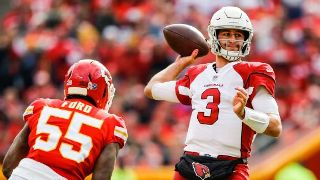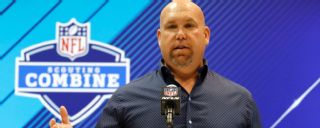|
TEMPE, Ariz. -- Nine games into the 2015 season, the Arizona Cardinals were rolling. They were 7-2 and three games into a nine-game winning streak. They had all the pieces of a Super Bowl contender: a veteran quarterback in MVP-candidate Carson Palmer, a tight-knit secondary led by defensive player of the year candidate Tyrann Mathieu and solid line play on both sides of the ball. They had the best offense in the NFL, leading the league in yards per play and yards per game, and averaging almost 31 points per game. They ended the regular season with the No. 2 seed in the NFC, but their Super Bowl hopes were dashed in a blowout loss to the Carolina Panthers in the NFC Championship Game. And then, slowly, general manager Steve Keim began disassembling the team piece by piece. That, coupled with a series of draft classes that didn't live up to expectations, has led the Cardinals to this: A 2-7 start in 2018 and a roster rife with holes. After back-to-back playoff appearances in 2014 and 2015, the Cardinals will spend their third straight January at home. Reaching the playoffs in the foreseeable future seems like a stretch. As of this week, the Cardinals have the fourth pick in the 2019 NFL draft, their highest selection since 2004, when they drafted Larry Fitzgerald third overall. Will that be the answer to the Cardinals’ problems this season? History shows Keim's once-hailed draft acumen has been on the decline, though his 2018 class shows promise. This next draft might be one he can't afford to miss on. When he became general manager in 2013, Keim stressed building Arizona's roster through the draft and did that. Of the 23 draft picks from 2013 to 2015, 17 were on the 2015 roster. But that's changed. No one from his 2013 draft is on the roster and only linebacker Deone Bucannon is left from his 2014 draft. Five remain from 2015, two from 2016, five from 2017 and six from the most recent class. Of Keim's 42 draft picks, 18 are still Cardinals, or 42.9 percent. That rate falls in the middle of the league.  Mostly first-round failuresGeneral managers aren't typically defined by the totality of their draft classes so much as their first-round picks. And that's where Keim has missed the most. 2013, No. 7 overall: Guard Jonathan Cooper flamed out after failing to clear the mental hurdles of a broken leg suffered during his rookie preseason. Keim's next five first-round picks are still on the roster, but three of them -- all defensive players, coincidentally -- have struggled this season. 2014, No. 20 overall: Deone Bucannon was moved as a rookie from safety to linebacker, where he’s spent the last five seasons as a hybrid defender. This season, Arizona planned for him to be the every-down inside linebacker who made the defensive calls but that didn't pan out and the duties were given to Josh Bynes. Coach Steve Wilks has hinted Bucannon didn’t execute his assignments early in the season, which led to a reduction in playing time. Bucannon has played 207 of 609 defensive snaps -- or 33.9 percent. He has never played less than 66 percent of the snaps in any of his first four seasons. Part of the reason for Bucannon’s reduced playing time is because when Arizona goes nickel, which they’ve done on 82.7 percent of their plays, Bucannon isn't on the field. When asked about Bucannon's playing time in late September, Wilks said: "I want to be able to put guys out on the field that I trust, that are going to be able to execute and do the things that we ask them to do, and that’s where it starts." 2015, No. 24 overall: When he "redshirted" his rookie season, it looked like tackle D.J. Humphries was on pace to be a flat-out bust. But it might have been the best decision for Humphries. He learned from Jared Veldheer and Bobby Massie and then took over as Arizona’s starting right tackle in 2016 before moving to left tackle in 2017, where he’s put himself in prime position to receive a big contract after the 2019 season. 2016, No. 29 overall: In defensive tackle Robert Nkemdiche, Keim thought he could have the same success he found with Tyrann Mathieu. Like Mathieu, Nkemdiche came with character issues. A projected top-five pick at one point, Nkemdiche fell to Arizona. His career has been marred by injuries and ineffectiveness. He has yet to play a full season: five games as a rookie and 12 last season. He's already missed two games this year. Former coach Bruce Arians called him out last season because of immaturity, and a lack of production this season caused Wilks to take him out of the starting lineup in Week 7 against the Broncos. Nkemdiche has shown some potential. He has a career-high 23 tackles and two sacks this season. Combine his lack of gap discipline with foot and calf injuries and Nkemdiche isn't producing at a first-round level. 2017, No. 13 overall: Haason Reddick hasn't lived up to the expectations, in part because positions changes. Under Arians, Reddick was drafted as an inside linebacker but had never played the position in a game. He was a defensive end in college at Temple and then transitioned to inside linebacker during the Senior Bowl. But the Cardinals moved him, yet again, during the 2017 season, to edge rusher. Under Wilks, he was moved back to inside linebacker. Reddick has been moved too much to be effective, despite his athleticism. He barely played the first four games, totaling 26 snaps. But he’s found a larger role since in Arizona's base defense more and nickel package. 2018, No. 10 overall: Keim missed opportunities to move up from to draft Deshaun Watson or Patrick Mahomes in 2017. The Cardinals finally got their quarterback of the future in Josh Rosen this past May. Rosen's a smart, talented quarterback who could be the face of a franchise.  A reason for optimismEarly in his tenure, Keim hit on a number of mid-round picks. He found success with his third-round picks starting with Mathieu in 2013. He then drafted wide receiver John Brown in the third round out of Pittsburg State in 2014 and running back David Johnson out of Northern Iowa in 2015. However, Keim’s third-round luck ran out in 2016 when he drafted Brandon Williams, a running back converted to cornerback, out of Texas A&M. The hope was for him to become the Cardinals’ long-term answer at corner opposite Patrick Peterson but Williams was never able to grasp the intricacies of the position. The verdict is out on Keim’s 2017 third-round pick, Chad Williams out of Grambling State, although he has improved since his rookie year. Keim’s last three second-round picks -- Christian Kirk in 2018, safety Budda Baker in 2017 and linebacker Markus Golden in 2015 -- have all been impact players. Baker was a Pro Bowler as a rookie, Golden led the team in sacks in 2016 and Kirk is one of the best rookie receivers in the NFL. Keim's first four picks of 2018 -- Rosen, Kirk, center Mason Cole and running back Chase Edmonds -- have all been on the field at the same time. Rosen, Kirk and Cole are starting. Last May's class may be the one Keim needed to start a new run of success, especially since the Cardinals are likely to add another high pick next spring. But Keim may not have room to miss again, especially if the Cardinals have another poor showing in 2019.
|

